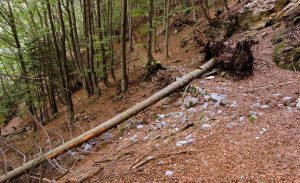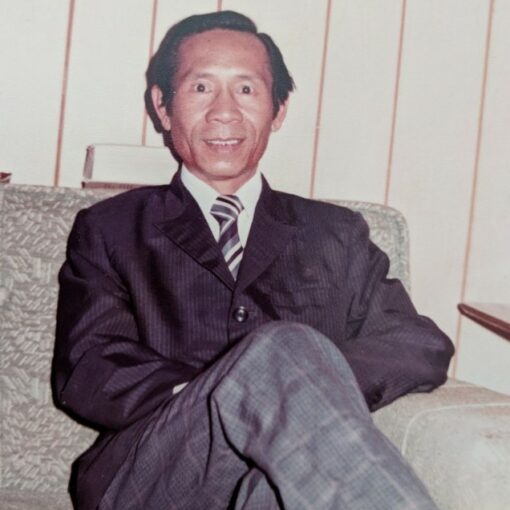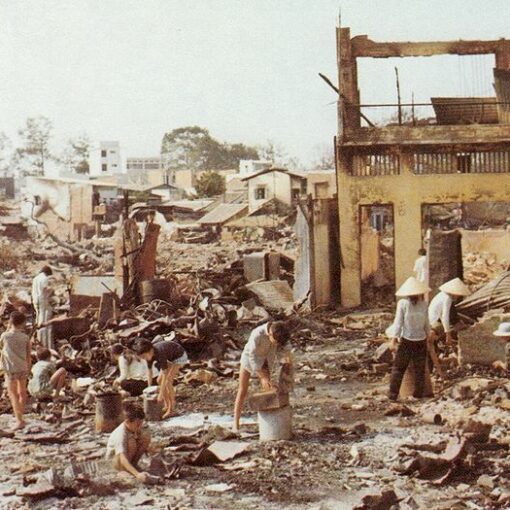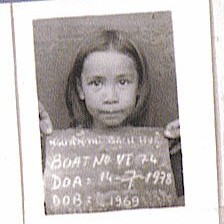From 1975 to about 1996, more than 500,000 boat people reportedly stayed at different refugee camps while a guess estimate of between 200,000 and 400,000 (10 to 70%) Vietnamese boat people perished on the high seas. Many boat people faced storms, diseases, starvation, and pirates. Often refugee boats were attacked by pirates an average of three times each. ![By PH2 Phil Eggman [Public domain], via Wikimedia Commons 800px-35_Vietnamese_boat_people_2](https://phoqueencooking.com/wp-content/uploads/2018/01/800px-35_Vietnamese_boat_people_2-201x300.jpeg)
During the pirate attacks, women were raped, abducted, and people were dead or missing. The number of Vietnamese boat people who died at sea could only be guessed.
Regardless of the perilous journey at sea, and over an alarming number of boat people grew to tens of thousands per month from 1978 to early 1979. Neighboring countries with international assistance set up refugee camps along their shore to help house the refugees until they were approved for resettlement in other countries.
Pulau Bi Dong was among the largest refugee camps during the Vietnamese migrations.
Pulau Bi Dong
![By diligam_te (Flickr: pulau bidong 11) [CC BY 2.0 (http://creativecommons.org/licenses/by/2.0)], via Wikimedia Commons 800px-Pulau_bidong_11](https://phoqueencooking.com/wp-content/uploads/2018/01/800px-Pulau_bidong_11-300x204.jpg) Pulau Bi Dong is one of the many beautiful islands located in Terengganu, the east coast state of peninsular Malaysia. Legend has it that the island was a home of an elderly childless couple who live in isolation away from others. After their demise, the island is uninhabited until 1978 when it was converted into a refugee camp for the Vietnamese Boat People, after the temporary camp at Pulau Besar in Merang could no longer accommodate the increasing number of refugees’ arrival since the first landing in May 1975.
Pulau Bi Dong is one of the many beautiful islands located in Terengganu, the east coast state of peninsular Malaysia. Legend has it that the island was a home of an elderly childless couple who live in isolation away from others. After their demise, the island is uninhabited until 1978 when it was converted into a refugee camp for the Vietnamese Boat People, after the temporary camp at Pulau Besar in Merang could no longer accommodate the increasing number of refugees’ arrival since the first landing in May 1975.
Pulau Bi Dong became designated to be the principal refugee camp in Malaysia in August 1978. It was one square kilometer or 0.386 square miles in area and located off the coast of Terengganu, Malaysia in the South China Sea. Bi Dong island was officially opened as a refugee camp on August 8, 1978, with 121 Vietnamese refugees’. Only the southern side of the island was used for the refugees’ while 90% of the island was considered to be a forbidden area.
In 1978, our boat was among the first 5 refugee boats to arrive at Pulau Bi Dong. The capacity of the refugee camp was estimated to be 4500. By June 1979, there were up to 40,000 refugees (ten times the capacity) living in the designated area, which was rounded by the white line. From 1975 until 1991, almost 250,000 boats came through Pulau Bi Dong. It was the largest refugee camp during the Vietnamese migrations.
When we first arrived, the island was uninhabited. For the first few weeks, I remembered living under a huge tent while the men built us a home. There were no hospitals, offices, shelters, or outhouses built. We all lived off of 1 well water. Later more wells were built and outhouses were also built.
In the beginning, the refugees like my family lived under trees, tents, or any shelter we could put together. Bushes or anywhere on the island were our public toilets. We dug wells throughout the island to get fresh water. Coconuts, coconut milk, and fish along with rice given by the government were our main staples.
We were fortunate to receive the support of the UNHCR. We received rice and condensed milk for the children once or twice a month. The bulk of my family was children so we did not consume all the rice. My mom traded the extra rice for the extra food such as vegetables for the family. My cousins went fishing for our extra protein consumption.
My memories of Crazy Incidences
I remembered three crazy incidents when we were living on the island. One incident was the fallen coconut tree. During one of many tropical storms, one coconut tree was being knocked over by a strong gust of wind. There was a small house or tent built
 right underneath the fallen path of the tree. As the tree was quickly leaning over, the residence of the house thought he could save the house by putting his arms up to stop the tree from falling on top of his house. To his dismay, the tree was too big and heavy. His house could not be saved. In the process, he broke both of his arms. It was not a happy ending.
right underneath the fallen path of the tree. As the tree was quickly leaning over, the residence of the house thought he could save the house by putting his arms up to stop the tree from falling on top of his house. To his dismay, the tree was too big and heavy. His house could not be saved. In the process, he broke both of his arms. It was not a happy ending.
Another incident was a suicide attempt by a famous singer who also was a refugee at Pulau Bi Dong. She was unhappy and wanted to end her life by jumping into the water well. Needless to say, her wish did not come true. The water well was shallow so she did not fall very far. Nothing was broken and many people were angry with her. We could not drink water from this well for months because it became diluted with all the dirt and mineral mixed in by her fall. It took a while for the water to be resettled and become clear again.
![By Original Photo by Wmpearl - SVG by Offnfopt [Public domain or CC0], via Wikimedia Commons beware falling coconuts sign](https://phoqueencooking.com/wp-content/uploads/2018/02/BEWARE_FALLING_COCONUTS_sign_in_Honolulu_Hawaii-Vector.svg_-293x300.png)
The third incident was the fallen coconut. My cousin was sitting under a coconut tree one-day chopping wood for dinner. He heard a loud thud along with a splash of juice spurted all over his feet. A large coconut fell off a tree and landed right next to my cousin. He was very fortunate that it did not land right on his head. With a high velocity, gravitational pull, and approximately 3-pound weight, the coconut could definitely do some damage to a person’s head.
Conditions of Pulau Bi dong
Conditions on Pulau Bi Dong were difficult over time. It was known to some as “Hell Isle”. New refugees’ were packed into the camp daily. My family and I were fortunate to leave the island by late November 1978. Even as a child at the age of ten, I could tell that the living sanitary condition was slowly degrading.
As the years progressed with more refugees’ arrival, the Malaysian Government, Malaysian Red Crescent Society (MRCS), UNHCR, and other relief agencies stepped in and created longhouses, hospitals, schools, clinics, temples, churches, shops, offices, modern public toilets, and many others. This helped relieve and created somewhat better conditions to house all the refugees.
Pulau Bi Dong opened on August 8, 1978, and officially closed with a farewell ceremony on October 30, 1991. When the camp was closed, the remaining refugees were forcefully repatriated back to Vietnam.
Current State of Pulau Bi Dong
After 14 years after the closure of the camp. The ex-workers of the island and a group of ex-Vietnamese refugees from Australia and the USA had a chance to revisit Pulau Bi Dong together in March 2005. The group created a memorial statue at Pulau Bi Dong & Galang in commemorated the hundreds of thousands of Vietnamese people who perished on the way to freedom (1975 – 1996). The memorial was demolished in June 2005. Here is a link to more information about the memorial: http://boatpeople75.tripod.com/VC_destroyed_Boat_People_Memorial.html.
I found a video of Pulau Bi Dong today on youtube.com while putting this blog together so I thought I share it with you.
Pulau Bi Dong became a deserted island. No one lives there anymore. There were proposals to turn Pulau Bi Dong into a vacation spot and/or museum. However, because of political reasons, very little to no maintenance has been done.
My thoughts
Even though Pulau Bi Dong may be a living hell for many but I had many fond memories of my time being there. My family and I were Robinson Crusoe. My siblings and I were the mermaids and mermen of the sea. We were the explorers of the new world. We were fortunate to be the first wave of people to live on the inhabited island. We built our own home and experienced pristine nature. There was no electricity, no plumbing, or no amenities existed. Everything was new and unexplored.
Many thanks to my parents who were courageous and fearless. They were in their early to mid-forties. We made the best out of what we had. My dad made up stories that excited us instead of feeling scared and hopeless. We were hopeful and felt relieved with the minimal burden from the outside world. Being there together as a family was one of the best times of our life. The best thing was we had each other.
That experience helped shape who I am today. My parents taught me not by words but by their examples, their actions, and their state of being.
After six months of paradise, we thought, we were sponsored to America. Check out my next article about our family reunion in America.
If you have any questions or comments, please leave a few words below. I love to hear your perspectives.
Resources:
http://pulaubidong.org/
https://en.wikipedia.org/wiki/BiDong_Island
https://en.wikipedia.org/wiki/Vietnamese_boat_people
https://commons.wikimedia.org/
http://maxpixel.freegreatpicture.com/




